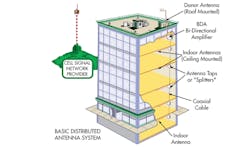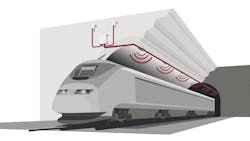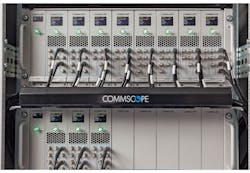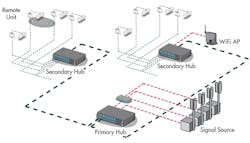This file type includes high resolution graphics and schematics when applicable.
Increasingly, distributed antenna systems (DASs) have been providing much-needed wireless service in locations ranging from sports stadiums to private yachts. The term “DAS” describes a network of antennas and interconnects that route telecommunications signals throughout a localized environment. The goal of a DAS is to bring wireless connectivity to areas where macrocells cannot adequately meet demand. There are three main types of distributed-antenna systems. Yet all of them encounter challenges when it comes to installation. Several companies have intriguing methods of solving those challenges, such as the need to implement high-capacity data links alongside often necessary public-safety bands.
Related Articles
• New Modulation Schemes Raise PIM
• Price, Power, And Size Drive Attenuator Advancement
• Interview: Bob Giometti, SkyCross
DASs are becoming more commonplace in corporate, public-transportation, and entertainment/shopping facilities (Fig. 1). When asked what is influencing this trend, Colin Abrey, Chief Marketing Officer of Zinwave, replies, “The biggest one at the moment is the proliferation of mobile data. To generate the best performance, you need to put the user close to the antenna. There is also an increasing demand for public-safety services to be available inside a building.” Wireless network operators have an incentive to provide coverage wherever their customers require network access. This demand for coverage precipitates a need for solutions that can maintain connectivity indoors, outdoors, and on the go (Fig. 2).
Because macrocells are designed for coverage over large outdoor areas, the communications link between a user’s devices inside a building and the tower may not always have a strong signal. A weak or sporadic signal would induce a much lower-capacity link and put less data at the fingertips of the user. DASs and small cells have been promoted as solutions for these problems. These approaches differ by the scenarios in which they provide the best solution. According to Abrey, “DASs would not typically be found in very small buildings or homes. Smaller environments that are single service would not typically use DASs; they would use small cells. A medium to large building, about 50,000 square feet and beyond would be the realm of DASs, as well as multi-service environments like 2G, 3G, and 4G-LTE.”
The oldest style of the distributed antenna system is fully passive. These systems are designed with a repeater antenna, which is mounted on roofs to relay the cell-tower signals to distributed antennas within the building. Passive DASs often require long runs of coaxial cables and repeaters, which are necessary for signal integrity considering the losses of the cable. Such systems may not be suited for all environments when considering costs and in-building routing.
Though wideband, this style of fully passive DAS is limited to the capacity of the repeater channel. It is therefore not suited to high-capacity links. The challenges of passive DAS include coexistence, passive intermodulation (PIM), and other types of interference. Among the solutions that can help mitigate these problems are quasi-omnidirectional antennas and antenna test sweeps with PIM equipment throughout the location. As most of these performance issues are derived from signal-routing problems, fiber-optic and unshielded-twisted-pair (UTP) cabling solutions have found a place in the market.
Hybrid DASs rely on a fusion of passive and active systems. The passive portion of the hybrid DAS includes the last few meters of coaxial cabling and the electronics that convert optical signals into RF signals. The active portion of the system is usually a fiber-optic signal path that connects directly with a base station and is routed to hubs distributed throughout a building.
The goal of all DASs is to offer operation on all frequencies that benefit the end user. This includes common cellular bands as well as public-safety and even WiFi bands. Mike Williamson, Director of DAS Product Line Management for CommScope, shares, “Distributed antenna systems should be designed to support any technology today and in the future. There may be some technical challenges with the systems when new frequency bands are released.” Williamson notes that DASs often have frequency-selective circuitry. Using amplifiers and filters as an example, a system will not be able to provide service if the amplifier or filters used in the DAS do not operate across the frequencies of interest. Such an approach would require adding new components to the system—potentially increasing cost and complexity (Fig. 3).
This file type includes high resolution graphics and schematics when applicable.
Mitigating Interference
This file type includes high resolution graphics and schematics when applicable.
Because fiber optics are less lossy than coaxial cables, the benefits of using technologies like fiber optics for routing include lower-cost cabling, easier routing paths through complex building structures, and lower power. Hybrid and passive DASs require amplification technology to increase the power levels in the sections preceding the lossy passive-cabling parts. Yet hybrid systems still suffer from interference issues, as the impact of the interference is directly related to the strength of the signals in the system.
A fully active DAS is a solution that distributes low-power points throughout the system and minimizes routing complexities. These DASs use optical routing that is similar to what is used by hybrid-DAS systems. But the fiber-optics and power infrastructure is routed directly to the point of antenna delivery (Fig. 4). In a large building, the wireless operators will generally have a room devoted to housing the operators’ various base stations, known as a base-station hotel.
In such a “hotel,” one or more main active DAS hubs will be connected to the operator’s base stations. To adjust the base-station signals to a nominal level and convert the signals from RF to optical signals, the necessary conversion electronics are contained within the main hubs. The signals carrying fiber optics are then routed to secondary hubs, which split and route the signals to the remote units. To save on high-powered electronic interconnects between the hubs and remote units, the remote units are individually powered. Some companies, such as Zinwave, use multimode fiber as interconnections between the base station and remote units. Beyond wideband capability, an additional benefit of this DAS typology is the potential to mitigate PIM throughout the system.
Related Articles
• New Modulation Schemes Raise PIM
• Price, Power, And Size Drive Attenuator Advancement
• Interview: Bob Giometti, SkyCross
Having low power levels at the remote units and extremely short runs of RF transmission lines could decrease the opportunity for PIM generators, along with good installation practice. Andy Bell, Chief Technical Officer for Zinwave, explains, “Our active DAS uses a transmit antenna and a receive antenna that are separated by 3 to 4 m, which is about -40 dB. That provides you with -40 dB of PIM protection. The antennas are only putting out 100 mW. By the time the 100-mW signal reaches the receiver, it is a tenth of a millwatt. A normal system only has a filter. That doesn’t provide any PIM protection because there is no isolation at the downlink frequency.” This type of approach allows for much lower-power systems that benefit from a less lossy cabling structure and a much wider-bandwidth. Additional cost savings from requiring less PIM-stringent components also could be considered in the return on investment of such a system.
DAS could bring connectivity to the bowels of a train tunnel system, a stadium full of photo-bombing fans, or a corporate complex that has merrily embraced bring-your-own-device (BYOD) mentality. Advances in DAS, including wideband multi-technology solutions, have gone a long way in expanding the scope of environments in which these systems can be found. Innately wideband interconnects within DAS enable more system flexibility while offering the potential to reduce failure modes. They could ensure future-proof platforms that can support the latest frequency bands and standards.
This file type includes high resolution graphics and schematics when applicable.





